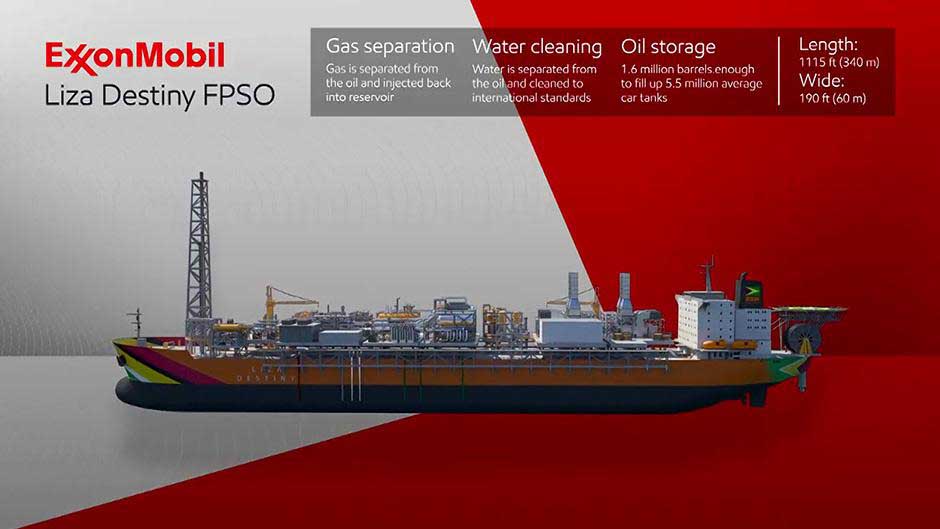The Ministry of Public Infrastructure (MPI) yesterday said that planning for the use of natural gas from the Liza-1 well began in September 2015 and continues to date even though more than nine billion cubic feet has already been controversially flared by ExxonMobil.
MPI’s statement was in response to a May 20th news item in Stabroek News which reported Jan Mangal, former petroleum advisor to President David Granger, expressing shock at the flaring and lamenting that a planned gas-to-power project had not taken off as planned.
Mangal said that he had insisted in 2018 that there be no flaring and that gas be brought to shore for electricity, fertilizer and other uses. He contended that ExxonMobil was flaring the gas to save money.
In another news item on May 25th, by which time it had been disclosed that the flaring volume was actually 9 billion cubic feet and growing, Mangal said this could have been avoided had the gas-to-shore pipeline project been implemented.
He said that ExxonMobil had already established a team to discuss the project and the Inter-American Development Bank (IDB) had said that it would fund a feasibility study of this country’s coastline to determine the most suitable location for the landing of the pipes and setting up of a power station.
“Myself and the IDB were pushing for a comprehensive feasibility study of the whole coastline so as to pick the best location for the landing of the pipeline onshore. This would be the location for the gas plant and the power plant would be nearby. But the Ministry of (Public) Infra-structure, they were against a comprehensive feasibility study. It seemed they just wanted to pick a location, and they proposed Mahaicony and another site just across the Demerara River from George-town. I was very suspicious of the Mahai-cony option because it made no sense to me and was a swamp,” Mangal told Stabroek News in an interview.
It is this view that MPI pushed back against yesterday by providing a chronology of events pertaining to gas pipeline.
In the aftermath of the reports, international lawyer Melinda Janki argued in a May 28 letter to this newspaper that Guyana’s ‘associated gas’ from the Liza well has no market value.
MPI’s statement yesterday said that “It is the Ministry’s intent to thank Stabroek News for the opportunity to set the record straight on the efforts of Government and its agencies on activities relevant to Guyana’s natural gas. The continued discussions, studies and activities show that the stakeholders were continuously engaged and involved in making steady progress in an informed, safe, and all-inclusive manner”.
The chronology provided by the ministry follows:
September 2015 – Cabinet was informed that Exxon was desirous of taking Liza 1 to early production, however this initial request may result in the flaring of the associated gas – cabinet advised that flaring of the gas would not be permitted – alternative solutions were requested.
February 2016 – Exxon informed that the re-injection of associated gas was possible. They were then requested to determine, if possible, what quantity of natural gas could be made available to be transported to shore without adversely affecting oil recovery.
July 2016 – Ministry of Public Infra-structure (MoPI) presented to cabinet the ‘Guyana Power Generation System Expansion Study’ supported by the Inter-American Development Bank (IDB), which included the option of powering part of our generating system by natural gas.
September 2016 – Based on the study, results and subsequent discussions, the Ministry of Natural Resources officially requested that Esso Exploration & Production Guyana Limited (EEPGL) considered the possibility of bringing gas to shore. The official agreement of this request occurred in February 2017.
February 2017 – The Government of the Co-operative Republic of Guyana (GoG) commenced early discussions and internal considerations for Associated Natural Gas in the first quarter of 2017. Discussions were held between the Ministry of Natural Resources, Ministry of Public Infrastructure and Esso Explo-ration and Production Guyana Limited (EEPGL) where it was reported that ExxonMobil continued to work towards a more detailed assessment of the implications of gas reinjection and gas export. Exxon confirmed the possibility of supplying 30 – 50 million cubic feet per day (MMcfd) to shore for the purpose of power generation.
March 1, 2017 – Ministry of Public Infrastructure commenced an independent Desk Study to provide pre-feasibility information. The study was titled ‘Options, costs, economics, impacts and key considerations of transporting and utilizing gas from offshore Guyana for the generation of electricity for local consumption’.
Jan Mangal appointed as Advisor to Ministry of Presidency – March 2017.
April 1, 2017 – Following a restricted tendering process utilizing firms on the IDB shortlist, the company, Energy Narrative was contracted on April 1, 2017 to conduct the Desk Study. During this period, Government continued meetings (April 27) with EEPGL regarding an Update and Status of activities and projections including further information on natural gas data, including composition, quality and potential volumes.
June 8, 2017 – Final Report of the desk study was Submitted by Energy Narrative to GoG with guidance on options, costs, economics, impacts and key considerations of transporting and utilizing gas from offshore Guyana for the generation of electricity for local consumption.
August 2017 – Visit by GoG Delegation to ExxonMobil Houston Campus & Meetings held where natural gas continued to be discussed between parties and three site areas were proposed by ExxonMobil for further consideration. Following this visit, the Ministry of Public Infrastructure established an independent Site Selection Team to provide options and recommendations regarding the landing of the pipeline and development of the power plant. This team comprised, Guyana Energy Agency (GEA), Guyana Power and Light (GPL), Ministry of Natural Resources, Guyana Lands and Surveys Commission, and Ministry of Business.
September 12, 2017 – Working Group (GoG) convened; The Working Group comprised key organizations including but not limited to MoPI, GPL, GEA, Ministry of Finance, GO-INVEST, Ministry of Business, Ministry of Natural Resources. The Working Group was convened to provide technical advice based on information and data submitted by ExxonMobil regarding gas to power generation.
September 19-20, 2017 – Working Group Discussion held between GoG and ExxonMobil. The key outputs involved a presentation of the Project Overview, Engagement and feedback from the Working Group and discussion on the way forward regarding activities to be pursued by the Working Group.
October 3 & 6, 2017 – the Working Group Discussions continued to focus on the Site Selection Report, where an additional site was proposed for a cost/benefit analysis.
Further meetings continued to be held among GoG representatives through 2017 into the first quarter of 2018.
November 2017 – Pursuant to the 2016 Study, the Government undertook an update of the Study on system expansion of the generation system, preparations for which commenced in November 2017, with support from the Inter-American Development Bank (IDB). This update was essential to develop scenarios for potential use of natural gas and renewable energy sources.
Concurrently, a draft Proposal for Full Feasibility Study was submitted by Energy Narrative to MoPI and IDB for consideration on November 3, 2017.
November/December 2017 – Preparation of documentation for procurement process with IDB for Update of the Study of the Generation System and System Expansion. In accordance with IDB process, this contract officially commenced in February 2018.
January 8, 2018 – to ensure continued transparency and awareness, a Cabinet Paper was prepared and presented on Site Selection and the Natural Gas Project.
February 2018 – Scoping meeting held between MoPI and World Bank to determine areas of possible technical cooperation and assistance. Brugman SAS was contracted by the IDB for the Update of the Study of the Generation System based on discussions and plans made in November/December 2017.
March 2018 – Feasibility Study commenced by Energy Narrative on technical and commercial aspects of the proposed natural gas project as an update to the Desk Study completed in 2017, which included components such as natural gas pipeline, LPG separation plant and power generation infrastructure. This full feasibility was commissioned to provide an overview of the project using further developmental data that had been gathered to date.
As an offshoot to this Feasibility Study, a technical ‘Gas to Power Study’ Expression of Interest was advertised by IDB for consulting services for a technical and economic feasibility study for the development of natural gas use in electricity generation in Guyana (hereinafter referred to as the ‘Gas to Power’ Study). This was followed by a Presentation to Cabinet by the Working Group on March 20, 2018. Following this presentation. Permission was granted to continue to explore further the most suitable sites identified the report.
April 2018 – Discussions and document preparation continued with the World Bank for the contracting of an Economic Advisor for Gas Matters.
Jan Mangal appointment as Advisor to Ministry of Presidency ended – April 2018
April/May 2018 – MoPI reconvened the Site Selection Team (as a Site Development Team) in April/May 2018 to conduct further internal developmental work to evaluate varying technical and economic considerations.
May/June 2018 – Completion and presentation of the Study by Brugman SAS commenced in February 2018 was made to GOG and stakeholders.
August 2018 Department of Energy (DOE) was established under the Ministry of
the Presidency. At this time, oil and gas matters were reverted to the DOE, with further discussions on natural gas being undertaken by the DOE. A Working Group was thus established in September 2019 with EEPGL regarding Associated Natural Gas.
As detailed above, the process of utilization of natural gas onshore commenced long before March 2017 and continued after April 2018.





